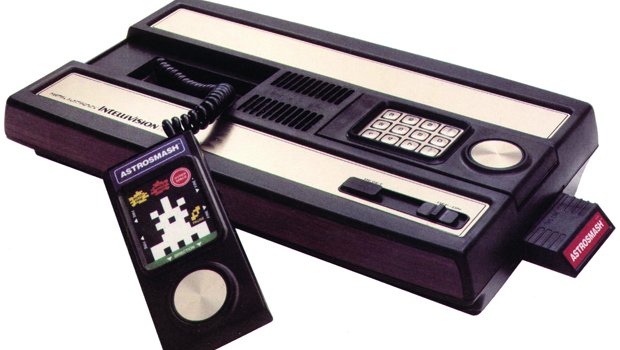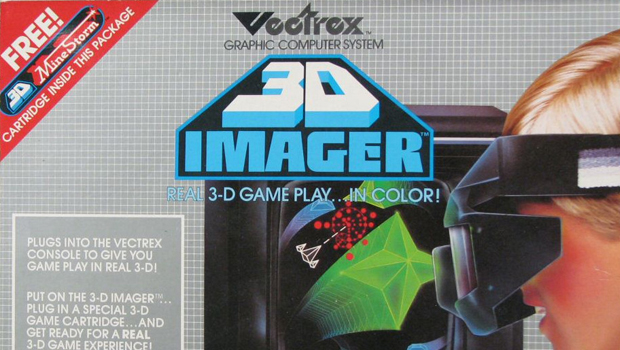Forgotten gaming hardware that was ahead of its time
They blazed a trail that no one followed for years
Too much, too early

Gaming is an art form founded on innovative technology, but that technology doesnt move in the straight line we tend to think it does. In fact, the last 30 years or so of gaming is littered with tons of unique, forward-thinking ideas and technological offshoots that turned out to be unpopular dead-ends--or, more often than not, simply didnt catch on until it was far too late to help their creators.
Some were good, some were bad, but we can look back at all of them and agree that they were on to something--and marvel that they were on to it so soon. And also that some of them went under so soon, because despite the popularity of whatever they were selling now, not enough people wanted it then. Over the next few entries, well take a look at these fallen heroes of innovation and just what, exactly, made them so special.
U-Force

Over the last year or so, the industry seems to have undergone a quiet realization that, hey, maybe shoehorning motion controls into games wasn't such a hot idea after all. It's a lesson it should have learned years ago--although to be fair, all of its previous console-level attempts at "putting players in the game" during the '80s and '90s were god-awful. Amid the heap of discarded Power Gloves and Activators, though, it's difficult to think of a device that was more forward-thinking--and more forgotten--than 1989s U-Force.
Essentially a pair of infrared panels that sensed the positions of players hands, the U-Force was designed for true hands-free gaming, with hand movements taking the place of controller inputs, and different configurations for different kinds of games. It also came with a couple controller-style accessories, including a flight-sim control yoke, but those were intended as training wheels that could theoretically be ditched once players got used to hands-free gaming. Sadly, few if any did, because U-Force was an unresponsive hunk of ass. An interesting idea, sure, but one for which 8-bit games--and infrared technology--just werent ready.
XBAND

Xbox Live may have been the beginning of dedicated, self-contained networks for consoles, but Microsoft wasnt the first to market with that idea. Oh, not by a long shot. In 1994, nearly a decade before Lives debut, XBAND brought SNES and Genesis players together using 2400-baud modems and a little bit of hardware trickery. It was awfully shaky, especially by todays standards, but at a time when online play meant Doom, dial-up connections and PCs, it was an ambitious idea.
For just $5 a month (not counting long-distance and connection fees), players could access XBANDs dedicated, nationwide network for head-to-head competition in Super Mario Kart, Mortal Kombat II, Doom, and a handful of other games that XBANDs creators had managed to reverse-engineer. It featured player profiles (complete with codenames and icon avatars), 10-person friend lists, leaderboards, news feeds, win/loss records, and even messaging via XMAIL. It also featured plenty of lag problems and rampant hacking, but in the end, console gamers and publishers simply didnt think online play was something they needed, and XBANDs network was shut down in 1997.
LaserScope

As youve probably realized by now, ahead of its time doesnt necessarily mean good--and while Konamis LaserScope, released in 1990, was inarguably a trailblazer in hands-free electronics and voice control, it was just as inarguably horrendous at both of those things. The ultimate in objects designed to cruelly trick dorky kids into thinking they look cool, the LaserScope was a combination voice headset, a light gun, and a hat. Below it was a lens with a crosshairs, meaning youd just have to look at targets to ensure perfect accuracy.
Weekly digests, tales from the communities you love, and more
The voice control part of the equation was that shouting fire! would cause the lightgun to shoot, heightening the tension of Operation Wolf and also of your parents in the next room. Problem is, Konami didnt actually put any voice-recognition technology into the LaserScope. Pretty much any noise--yelling fire, yelling buh, dogs barking, parents screaming at you from the other room--would set it off, rendering meaningless whatever accuracy it offered. Still, it paved the way for you to control your games by talking to Kinect. Which you totally do.
Sega Channel

XBAND may have been the predecessor to todays multiplayer-enabling online console networks, but it was missing one important feature that we now take for granted: Downloads. Thats where Sega Channel comes in. In 1994, Sega rolled out something that seemed unimaginable to Genesis gamers of the time: Unlimited access to dozens of games on demand.
These were real games, too; the kind that were going for $40 and up in stores. Sega Channel gave you up to 50 at a time for just $15 a month. And it didnt stop there, either--Sega Channel subscribers also got access to time-limited demos of unreleased games, as well as a chance to try out titles that were never released Stateside. It wasnt perfect--games only stayed downloaded for as long as the Genesis was powered on, and cable technology at the time could easily disrupt downloads--but for gamers in the days when the internet was just starting to catch on, it was a godsend. The service stayed alive until 1998, when the Genesis (along with its ill-fated successor, the Saturn) was finally retired.
Intellivision

While not entirely forgotten (at least not by its fans), Mattels 1979 Intellivision is a console that frequently gets ahead of its time lobbed at it, and for good reason. Not only did it sport a 16-bit processor and pack more visual oomph than the Atari 2600 it competed against, but it had a litany of add-ons including a keyboard (which allowed for programming), a voice synthesizer, and a controller with a thumbpad instead of a joystick. Oh, and also it pioneered cable-TV downloads in 1981, 13 years before Sega, and two years before the CVC GameLine added a similar feature to the 2600.
Using the PlayCable service, subscribers could play around 20 different titles each month--although much like the rest of the Intellivision, PlayCable never really caught on. With the early 80s game-industry crash looming, the service was shut down in 1983--and Intellivision followed suit the next year, leaving nothing but a bunch of great games and pining fans in its wake.
Vectrex 3D imager

Beloved by fans and homebrew programmers (and ignored by pretty much everyone else), the Vectrex was released in 1982, and was notable mainly for featuring a built-in, monochrome screen that only displayed vector (which is to say wireframe) graphics. However, decades before 3D became a Big Thing for current-gen gaming (and years before the clumsy attempts at virtual reality of the early '90s), Vectrex had something interesting up its sleeve: The 3D Imager.
Using a spinning color wheel that acted like an alternating shutter over each eye, the 3D Imager was a headset that synced with the Vectrex to create the illusion of color 3D graphics. Only three games were made for use with the Imager--kind of a lot, actually, considering that it was cranked out in small quantities right as the Vectrex ended its short lifespan. Still, the idea of a console using motorized glasses to achieve 3D gaming in 1984 is an irresistible kind of crazy--as is the fact that a few dedicated Vectrex fans have even made their own.
Famicom Modem

You know that stocks app installed on your phone? The one you maybe cant get rid of? Well, it might interest you to know that thats just the latest iteration of the financial powers-that-be trying to turn fun things into glorified stock tickers. In fact, no less an entity than Nintendo was involved in such an attempt in 1988, when it partnered with Nomura Securities to create a modem for the Famicom (aka the NES) that would enable Nomuras Japanese customers--filled with market enthusiasm thanks to Japans then-bubbling economy--to check, buy, and sell stocks online.
Of course, Nintendo wasnt going to let it end at that; it also let users bet on horse races from home. Offering games and online multiplayer (and, more interestingly, add-ons for existing games) via the modem was always a goal for Nintendo, but one it wasnt able to realize, thanks largely to the limitations of late-80s phone networks and modem technology. By the time that sort of thing became feasible, it was time to move on to something more impressive. Something like
Satallaview

At this point, this article is dangerously close to becoming a catalog of early modems, but lets squeeze in just one more. The year after Sega launched the Sega Channel, Nintendo followed suit with its own service for the Super Famicom--but where Sega opted to use aging cable-TV infrastructure for its subscription service, Nintendo went a more futuristic route: a satellite modem. Used with the St.GIGA satellite-radio service, the Japan-only Satellaview let users download and play games that were broadcasted daily via satellite. Unlike Sega Channel, however, it didnt stop there.
Instead of navigating a menu to pick out which games they wanted, Satellaview owners played a game--The Story of the Town Whose Name Has Been Stolen, pictured above--with buildings that represented different content that could be downloaded (which changed hourly). And aside from possibly being the inspiration for PlayStation Home, Satellaview also let users download new content for existing games, as well as SoundLink games, which added voice-acting tracks to games like The Legend of Zelda, and which were only available to play during certain times of day. Amazingly, the service lasted well into the era of CD-ROM, internet and Pokemon, staying alive until 2000.
I, Robot

Today, the arcade flop I, Robot looks like little more than a colorful jumble of polygons that wouldnt be out of place among other early 3D games of the early 90s. So what sets it apart? Well, for starters, its the early 3D game. Of the early 80s. Able to render 2,000 polygons at once and offering camera angles and gameplay unheard-of at the time, I, Robot completely baffled arcade-goers of 1983, who then presumably wandered off to excitedly wait in line for Dragons Lair.
Its a shame the game bombed, not only because its success could have pushed graphics ahead 10 years, but because it actually holds up reasonably well today. The controls can be a little weird (pushing both Start buttons switches the camera angle? What?), but your goals--which involve jumping around on blocks and obeying the arbitrary rules laid down by a giant, evil eye--are explained as you play, and the actions not too difficult to wrap your mind around if youre already used to moving in a 3D space. In games, we mean.
Paved (over and crushed in a desert) with good intentions

While weve covered most of the more notably ignored (or at least forgotten) innovators of the last few generations, there are still plenty we havent touched on--and maybe even a few that wont be recognized as ahead of the curve until their tech is picked up, dusted off, and made amazing years from now. In any case, we know youd love to tell us which ones we forgot, so head down to the comments below and let your voice be heard.
And if you're looking for more glimpses of gaming's past, check out the top 7 most ambitious flops in gaming and gaming's most hated technology failures.



